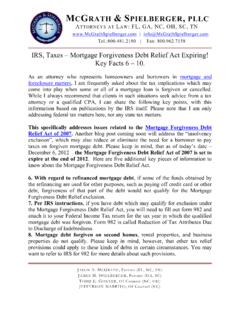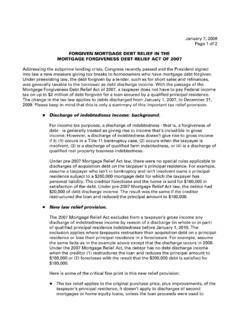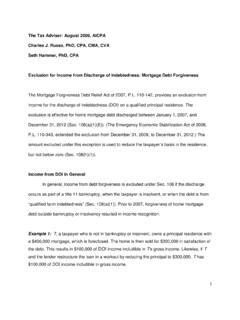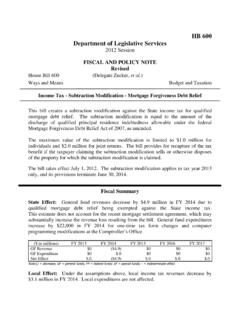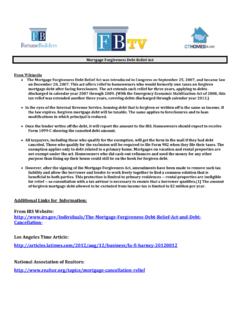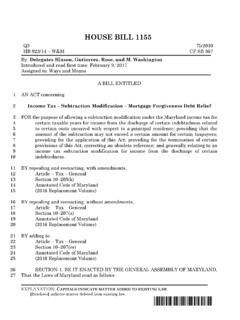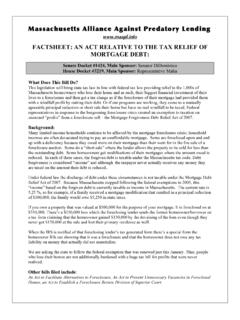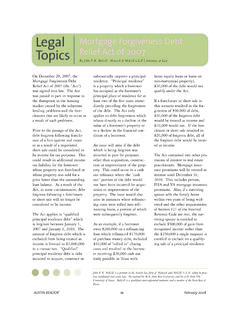Transcription of HB 1155 Department of Legislative Services 2017 Session
1 HB 1155 department of legislative services 2017 Session FISCAL AND POLICY NOTE First Reader House Bill 1155 (Delegate Hixson, et al.) Ways and Means Income Tax - Subtraction Modification - mortgage forgiveness debt relief This bill reestablishes the subtraction modification against the State income tax for qualified mortgage debt relief . The subtraction modification may be claimed for the amount of the discharge of qualified principal residence indebtedness allowable under the federal mortgage forgiveness debt relief Act of 2007, as amended.
2 The maximum amount of the subtraction may not exceed $100,000 ($200,000 if married filing jointly). The bill takes effect July 1, 2017 . The subtraction modification applies to tax years 2017 and 2018 and terminates June 30, 2019. Fiscal Summary State Effect: General fund revenues decrease by $ million annually in FY 2018 and 2019 due to qualified mortgage debt relief being exempted against the State income tax. General fund expenditures increase by $53,000 in FY 2018 due to one-time computer programming expenses at the Comptroller s Office.
3 ($ in millions) FY 2018 FY 2019 FY 2020 FY 2021 FY 2022 GF Revenue ($ ) ($ ) $0 $0 $0 GF Expenditure $ $0 $0 $0 $0 Net Effect ($ ) ($ ) $ $ $ Note:() = decrease; GF = general funds; FF = federal funds; SF = special funds; - = indeterminate increase; (-) = indeterminate decrease Local Effect: Local income tax revenues decrease by $ million annually in FY 2018 and 2019. Local expenditures are not affected. Small Business Effect: None. HB 1155/ Page 2 Analysis Current Law: Subject to specified exceptions, the State generally conforms to the federal tax treatment of canceled debts, foreclosures, repossessions, and abandonments.
4 The amount of income that must be realized or excluded for State income tax purposes in these circumstances is determined under the federal income tax. The federal mortgage forgiveness debt relief Act of 2007 enacted a temporary measure that excludes from the gross income of a taxpayer any discharge of indebtedness income by reason of a discharge of qualified principal residence indebtedness. The exclusion most typically applies to real estate short sales, loan modifications, and foreclosures.
5 Qualified principal residence indebtedness includes: any debt incurred in acquiring, constructing, or substantially improving a principal residence and which is secured by the principal residence; and any debt secured by the principal residence resulting from the refinancing of debt incurred to acquire, construct, or substantially improve a principal residence, but only to the extent the amount of the debt does not exceed the amount of the mortgage principal prior to refinancing.
6 A principal residence is generally the home where the taxpayer lives most of the time. A taxpayer can have only one principal residence at a time. The maximum amount that can be treated as qualified principal residence indebtedness is $ million ($ million if married filing separately). Subsequent federal legislation extended the exclusion, most recently through tax year 2016. The exclusion may apply if the indebtedness is discharged after December 31, 2016, if the discharge is subject to a prior written agreement.
7 Chapters 544 and 545 of 2012 created a subtraction modification against the State income tax in tax year 2013 for qualified mortgage debt relief . The subtraction modification was equal to the amount of the discharge of qualified principal residence indebtedness allowable under the federal mortgage forgiveness debt relief Act of 2007, as amended. The Acts provided for recapture of the tax benefit if the taxpayer claiming the subtraction modification sells or otherwise disposes of the property for which the subtraction modification is claimed.
8 Chapters 528 and 529 of 2014 extended the subtraction modification to tax years 2014 and 2015 and specified that the maximum amount of the subtraction may not exceed $100,000 ($200,000 if married filing jointly). Since the federal exclusion was extended through tax year 2016, the State subtraction modification generally did not apply. HB 1155/ Page 3 Background: Federal Cancellation of debt Income Provision When an individual borrows money, the loan proceeds are not recognized as income because there is an obligation to repay the lender.
9 Under the federal income tax, if an individual borrows money from a lender and the lender later cancels or forgives the debt , the cancelled amount of debt is required to be reported as income under certain circumstances. For example, if an individual borrows $10,000 and defaults on the loan after paying back $2,000 and the lender is unable to collect the remaining debt , there is a cancellation of debt of $8,000 that must be reported as income by the taxpayer. This income is referred to as cancellation of debt (COD) income under the Internal Revenue Code and is taxable as ordinary income.
10 The American Recovery and Reinvestment Act of 2009 contained a provision that allowed certain businesses to elect to defer, and include ratably over five tax years, any income from the discharge of business debt arising from the reacquisition of certain specified types of business debt repurchased in 2009 and 2010. The Budget Reconciliation and Financing Act of 2009 (Chapter 487) permanently decoupled the State income tax from this specific COD income provision. Chapters 320 and 321 of 2014 created a subtraction modification against the State income tax for income resulting from the discharge of student loan debt due to total and permanent disability or death.










